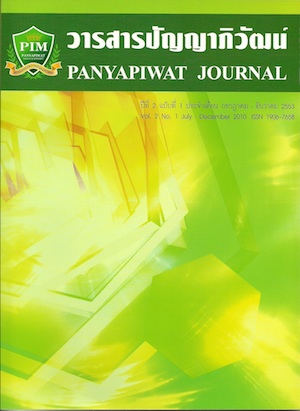The Study of Influential Factors for Developing Industrial Agglomeration in Thailand
Main Article Content
Abstract
บทคัดย่อ
ในเดือนตุลาคม พ.ศ.2549และเดือนพฤศจิกายน พ.ศ. 2550 ได้มีการสำรวจโดยแบบสอบถามเพื่อทำการศึกษาถึงการก่อตัวของกลุ่มอุตสาหกรรมในพื้นที่กรุงเทพมหานครและจังหวัดใกล้เคียงของประเทศไทย ข้อมูลที่ได้จากการศึกษาทั้งสองครั้งนี้ได้นำไปสู่การศึกษาการรวมกลุ่มอุตสาหกรรมและปัจจัยที่มีอิทธิพลที่สนับสนุนให้เกิดการเกิดการรวมตัวกัน จากข้อมูลบางส่วนของการสำรวจใน พ.ศ. 2549 พบว่า การรวมตัวกันของอุตสาหกรรมของประเทศไทยสามารถแบ่งออกเป็นสามช่วงเวลา ได้แก่ ช่วงที่หนึ่งคือช่วงก่อน พ.ศ. 2529 ช่วงต่อมาคือช่วง พ.ศ. 2530 ถึง พ.ศ. 2537 และช่วงสุดท้ายได้แก่ช่วงหลัง พ.ศ.2537 ในช่วงที่หนึ่งจะเป็นการก่อตั้งของกลุ่มบริษัทขนาดใหญ่ และในช่วงหลังจะเป็นการก่อตั้งสถานประกอบการของกลุ่มบริษัทขนาดรองๆ ลงมาเพื่อทำธุรกิจกับกลุ่มบริษัทขนาดใหญ่จนเกิดการรวมตัวกันเป็นกลุ่มอุตสาหกรรม จากการสํารวจครั้งที่สองในเดือนพฤศจิกายน พ.ศ.2550 การสำรวจในครั้งที่สองนี้ มีวัตถุประสงค์เพื่อศึกษาปัจจัยที่มีอิทธิพลต่อการส่งเสริมการให้เกิดการรวมตัวกัน โดยมีปัจจัยที่ทำการศึกษาทั้งสิ้นยี่สิบปัจจัยในการสำรวจตรวจสอบ มีการแบ่งบริษัทที่ทำการศึกษาออกเป็นสองกลุ่มคือ บริษัทขนาดใหญ่ และบริษัทขนาดเล็ก พบว่า มีบางปัจจัยที่มีผลต่ออย่างมีนัยสำคัญต่อการกระตุ้นให้เกิดการรวมกลุ่มอุตสาหกรรม เช่น บริษัทขนาดใหญ่ที่ถูกดึงดูดโดยแรงจูงใจการลงทุน โครงสร้างพื้นฐานทางกายภาพ ระบบกฎหมาย ความพร้อมของแรงงานที่มีทักษะ และสภาพความเป็นอยู่ของพลเมือง ในขณะที่ปัจจัยที่มีผลต่ออย่างมีนัยสำคัญต่อบริษัทขนาดเล็ก ได้แก่ ความพึงพอใจกับนโยบายของรัฐบาลในระบบการค้าอย่างเสรี และสิทธิในทรัพย์สินทางปัญญา แต่อย่างไรก็ดีไม่สามารถสรุปได้อย่างชัดเจนจากการสำรวจว่าการรวมตัวของกลุ่มอุตสาหกรรม ก่อให้เกิดนวัตกรรมอย่างมีนัยสำคัญ
คำสำคัญ : การรวมกลุ่มอุตสาหกรรม, กลุ่มอุตสาหกรรม, นวัตกรรม
ABSTRACT
Based on data obtained from the mail survey conducted in October 2006 and November 2007, this study analyzes nature and characteristics of industrial agglomeration in the Bangkok Metropolitan Area of Thailand in order to investigate the formation of industrial agglomeration and influential factors for the agglomeration formation. As part of the survey in 2006, it was shown that the industrial agglomeration in Thailand could be divided into three periods (before 1986, 1987-1994 and after 1994). The early period was establishments of large firms, while the later was establishments of smaller firms forming themselves around the large firms to become the agglomeration. Furthermore, another survey was done in 2007, aiming to identify influential factors encouraging the development of such agglomeration. In this regard, there were twenty factors investigated in the survey. The firms were divided into two groups, namely, large firms and small firms. It was found that some of the factors significantly affect the development of the Thai industrial agglomeration. For examples, the large firms were attracted by investment incentives, physical infrastructure, legal systems, availability of skilled labor and living conditions, while the small firms were satisfied with the government policies on trade liberalization and system of intellectual property rights. However, the innovation of agglomeration cannot be concluded clearly since the results from the analysis showed that there was no significant common factor to explain the upgrading of industry among models.
Keywords : Industrial Agglomeration, Industrial Clustering, Innovation
Article Details
I and co-author(s) certify that articles of this proposal had not yet been published and is not in the process of publication in journals or other published sources. I and co-author accept the rules of the manuscript consideration. Both agree that the editors have the right to consider and make recommendations to the appropriate source. With this rights offering articles that have been published to Panyapiwat Institute of Management. If there is a claim of copyright infringement on the part of the text or graphics that appear in the article. I and co-author(s) agree on sole responsibility.
References
Barro, R. J. and X. Sala-I-Martin. (1995). Economic Growth, McGraw-Hill, New York.
Fujita, M. and J.-F. Thisse. (2002). Economics of Agglomeration: Cities, Industrial Location, and Regional Growth, Cambridge University Press, Cambridge.
Greene, W. H. (2000). Econometric Analysis, 4th edition, Prentice-Hall, Upper Saddle River, N.J.
Hobday, M. (1995). Innovation in East Asia, Edward Elgar, London.
Kuchiki, A. (2003). Agglomeration of Exporting Firms in Industrial Zones in North Vietnam: Players and Institutions. In: Industrial Agglomeration: Facts and Lessons for Developing Countries, (eds Tsuji M. and Kagami M.), pp. 118-53. IDE/JETRO, Chiba, Japan.
Kuchiki, A., and M. Tsuji (eds). (2005). Industrial clusters in Asia: analyses of their competi-tion and cooperation. Place of publication: Pragrave Macmillan.
Kuchiki, A., and M. Tsuji (eds). (2008). The flowchart approach to industrial cluster policy. Place of publication: Pragrave Macmillan.
Tsuji, M., Ueki, Y., Miyahara, M. and Komolavanij, S. (2006). “An empirical examination of factors promoting industrial clustering in Greater Bangkok, Thailand”, in Proceedings of 10th International Convention of the East Asian Economic Association. Bejin, China.
Tsuji, M. and M. Kagami. (2003). Industrial Agglomeration: Facts and Lessons for Developing Countries, IDE/JETRO, forth-coming from Edward Elgar in 2006.


